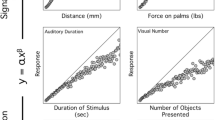Summary
In an attempt to regulate the many controls necessary when making quantitative observations of the brain's response to flicker, it was found that the presence or absence of stimulation of other sensory modalities exerted an influence. Experiments are described in both man and animal, in which a click has been paired with a flash and the influence of each on the response to the other has been studied by computer analysis. Examples are given of experiments in which some components of these responses are enhanced, others are diminished. It is hypothesized that relative stimulus strength may be the factor deciding which effect becomes the dominant one although individual differences in sensitivity doubtless exist. Computer studies of the variability of the potential differences that compose the average curve reveal the changes that develop during long periods of stimulation.
Résumé
En cherchant à exercer tous les contrôles nécessaires dans des observations quantitatives de la réponse cérébrale au flicker, il est apparu que la présence ou l'absence de stimulation d'autres modalités sensorielles, ont une influence. Des expériences sont décrites, à la fois chez l'homme et l'animal, dans lesquelles un clic est pairé avec un éclair lumineux, et l'influence de chacun sur la réponse provoquée par l'autre a été analysée avec une calculatrice. Des exemples sont présentés, dans lesquels certainse composantes des réponses sont augmentées, dans d'autres elles sont diminuées. Il est suggéré que l'intensité relative des stimuli pourrait être le facteur déterminant quel effet devient dominant, mais indubitablement des différences individuelles de sensibilité existent aussi. L'analyse de la variabilité des différences de potentiel, sur lesquelles la moyenne est calculée, révêle les modifications qui se développent durant les longues périodes de stimulation.
Zusammenfassung
Die Kontrolle der Versuchsbedingungen, die zur quantitativen Untersuchung der cerebralen Antworten auf Flimmerlichtreizung nötig sind, zeigte, dass das Vorhandensein oder Fehlen von Reizen anderer sensorischer Modalitäten einen Einfluss ausübt. Versuche an Menschen und Tieren werden beschrieben, bei denen ein Klick mit einem Lichtblitz kombiniert wurde; der Einfluss, den jeder der beiden Reize auf die Beantwortung des anderen ausübt, wurde mit einer Computer-Analyse untersucht. Beispiele werden gezeigt, bei denen einige Komponenten dieser Antworten erhöht, andere vermindert sind. Es wird angenommen, dass die relative Reizstärke der Faktor ist, der entscheidet, welcher Effekt dominiert, obwohl individuelle Sensitivitätsunterschiede zweifelsohne vorhanden sind. Computer-Untersuchungen über die Variabilität der Potentiale, aus denen sich die gemittelte Kurve zusammensetzt, zeigen die Veränderungen, die während langer Stimulationsperioden auftreten.
Similar content being viewed by others
References
Bradley, P. B. & Mollica, A. (1958) The Effect of Adrenaline and Acetylcholine on Single Unit Activity in the Reticular Formation of the Decerebrate Cat. Arch. ital. Biol. 96, 168–186.
Moruzzi, G. & Magoun, H. W. (1949) Brain Stem Reticular Formation and Activition of the EEG. EEG Clin. Neurophysiol. 1, 455–473.
Stevens, S. S. (1961) The Psychophysics of Sensory Function. In: Sensory Communication, Ed: W. A. Rosenblith, Wiley, New York, pp. 1–33.
Author information
Authors and Affiliations
Additional information
The work of this investigator is supported by Career Award #5-K6-NB-18, 608, (NINDB) and Grant NB 04773 from the United States Public Health Service; and by Contract Nonr 233(69) from the United States Office of Naval Research.
Brain Research Institute, University of California.
Rights and permissions
About this article
Cite this article
Brazier, M.A.B. A study of the variability of response to flicker: The influence of other sensory stimuli. Doc Ophthalmol 18, 221–237 (1964). https://doi.org/10.1007/BF00160575
Issue Date:
DOI: https://doi.org/10.1007/BF00160575




